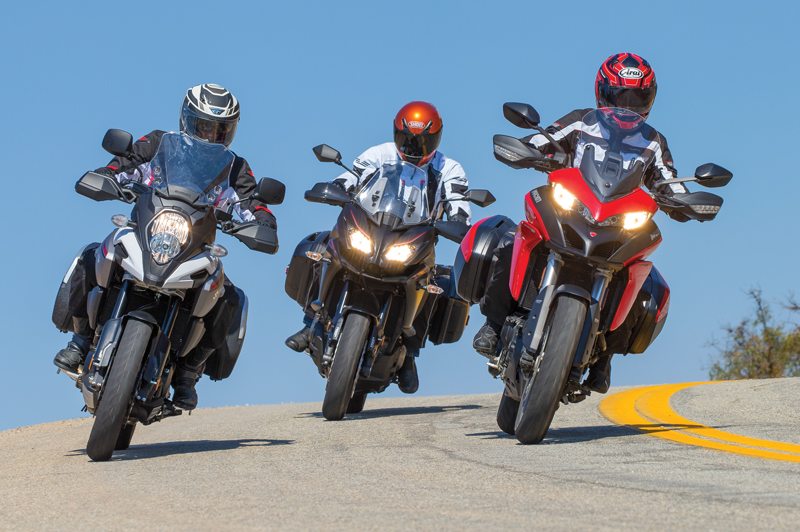
Summertime is for touring. Long days, warm weather and vacation days that have been squirreled away like acorns mean it’s time to pack the saddlebags and hit the road. Although this is our October issue, you’ll receive it during the dog days of August and we did our testing in early July. With 14 hours of daylight, we combined this three-bike comparison test with a three-day camping challenge (read that story here).
Ducati’s introduction of the Multistrada 950 for 2017 inspired us to revisit the “crossover” comparo we did a couple years ago (Rider, May 2015 and here), substituting the Ducati for the Yamaha FJ-09 and putting it up against the updated-for-2018 Suzuki V-Strom 1000 and the unchanged Kawasaki Versys 1000 LT. These street-biased adventure tourers have engine displacements ranging from 937cc to 1,043cc and as-tested prices ranging from $12,999 to $15,139. Only the Kawasaki comes with saddlebags as standard equipment, so we installed factory accessory saddlebags on the others. We stuffed our stuff in the saddlebags and packed our camping gear in dry-bag duffels, using Rok Straps to secure them to the back. Details about each bike can be found at the end of this comparison test, and in the spec charts and dyno graphs. Keep reading to find out how they match up.
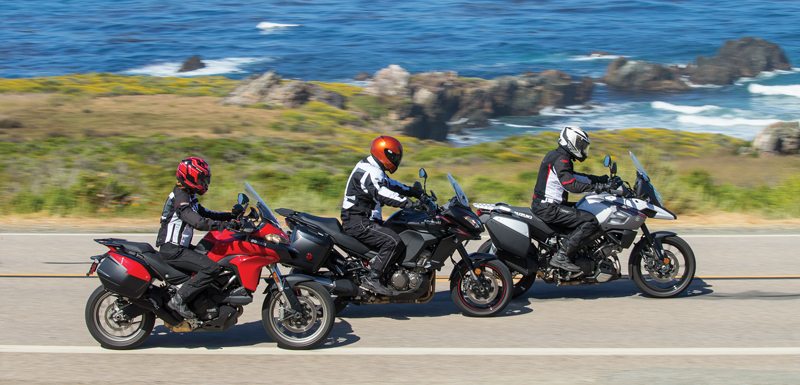
Apples to Apples
These are tall, heavy bikes, with seat heights ranging from 33.1 to 33.5 inches and wet weights ranging from 529 pounds for the Suzuki to 541 pounds for the Ducati and 564 pounds for the Kawasaki. Adding riders, supplies and camping gear made them even heavier. Fortunately, all have load capacities well over 400 pounds, stout chassis and suspensions up to the task of handling the added weight while we flogged them on technical roads. They also have 6-speed transmissions with assist-and-slipper clutches, chain final drive, standard ABS and traction control, 5.3-5.5 gallon fuel capacities with 200-plus miles of range, hand guards, luggage racks and cast wheels shod with tubeless tires. What stands out is the comparable level of overall competence among these bikes. None are far ahead or lag way behind the others; differences come down to the details.
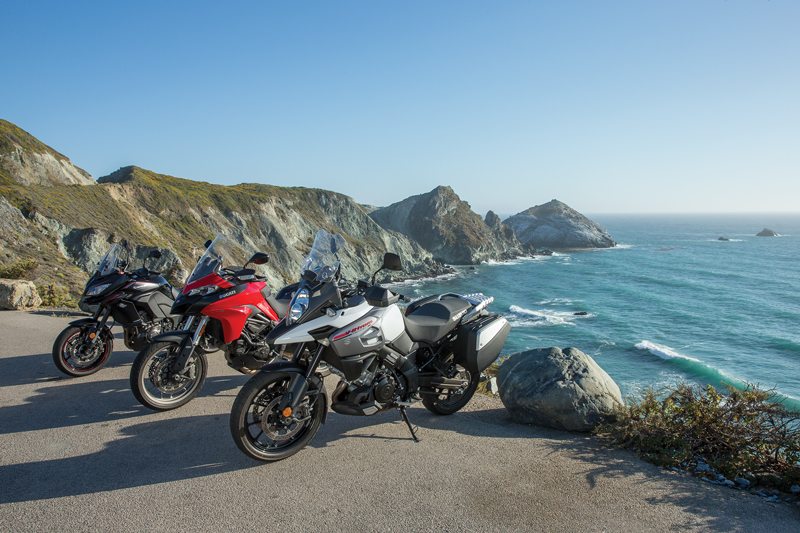
Get Up & Go
Sportbike DNA lurks within these bikes’ genetic code. The Suzuki’s 1,037cc V-twin is a descendant of the TL1000S powerplant, the Ducati’s 937cc L-twin can be traced back to the 1098 superbike and the Kawasaki’s 1,043cc in-line four began life in the Z1000. All were retuned for stronger low to midrange power, and they have flat torque curves and power that increases steadily as revs climb. On Jett Tuning’s dyno, the Kawasaki posted the highest peak figures: 109.6 horsepower at 9,400 rpm and 68.9 lb-ft of torque at 7,700 rpm. The Kawasaki and Suzuki are neck-and-neck below 7,000 rpm, at which point the Kawasaki surges ahead. With its 100-106cc displacement deficit, the Ducati makes much less horsepower and torque than the others below 7,000 rpm, and its peak horsepower advantage over the Suzuki—96.7 vs. 91.8—only emerges above 8,000 rpm.
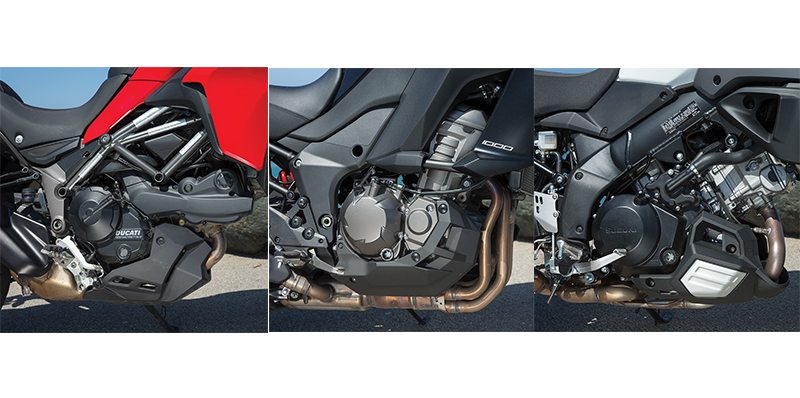
Compared to the two V-twins, the Kawasaki’s in-line four is impeccably smooth, doling out butter-rich power with spot-on throttle response. It loves to rev, encouraging us to stay a gear low just to hear it howl at high rpm. As the only bike here with a 17-inch front wheel and sport-touring rubber, the Versys 1000 dives in and out of corners with gusto, but it’s also the heaviest with the extra weight carried up high. Although its suspension is comfortably compliant most of the time, when pushed hard the Kawasaki feels vague and wallowy. In contrast, the Suzuki is the lightest, has great low-end grunt, neutral handling, firm suspension and the strongest brakes, and it’s the only one with the added safety net of cornering ABS, but it feels a little dull and its Bridgestone Battle Wing tires offer limited grip. With typical Italian flair, the Ducati is the liveliest of the bunch, making up for its lack of low-end power with a scrappy personality and a knack for cornering. Even with a 19-inch front wheel (like the Suzuki), when the road turns twisty, the Multistrada 950 is hard to beat. But its clutch can be grabby on takeoff, its front brake lever requires too much travel before the calipers bite and its too-low rear brake pedal feels wooden.
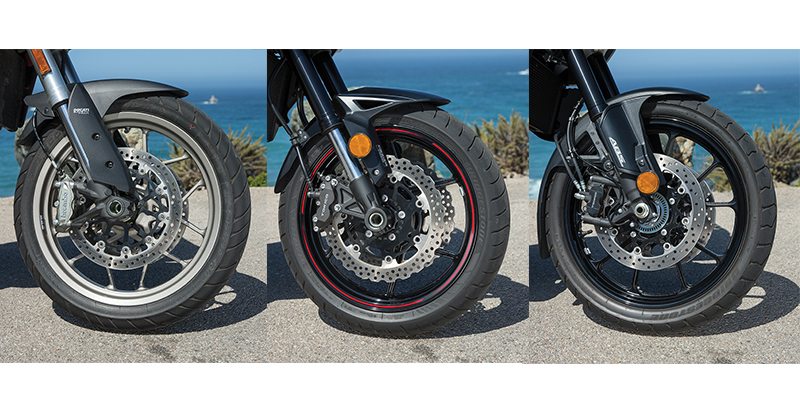
Into the Wind
Thanks to a record-breaking heat wave, our inland route had us dealing with highs well into triple digits. Our only relief came late in the day at two different campgrounds, one high in the mountains and the other on the coast. All three bikes radiate some engine heat, and their modest-sized fairings and windscreens part the airflow smoothly yet still allowed us to feel the blast-furnace wind on our shoulders and helmets. The Ducati offers the easiest windscreen adjustment—just pinch the lever with one hand and raise it up or down. No tools are required to adjust the Kawasaki’s windscreen, but you need to be off the bike to loosen the two hand-tightened nuts on the front. A ratcheting system allows the angle of the Suzuki’s windscreen to be adjusted by hand on the fly, but a hex wrench is required to change its height.
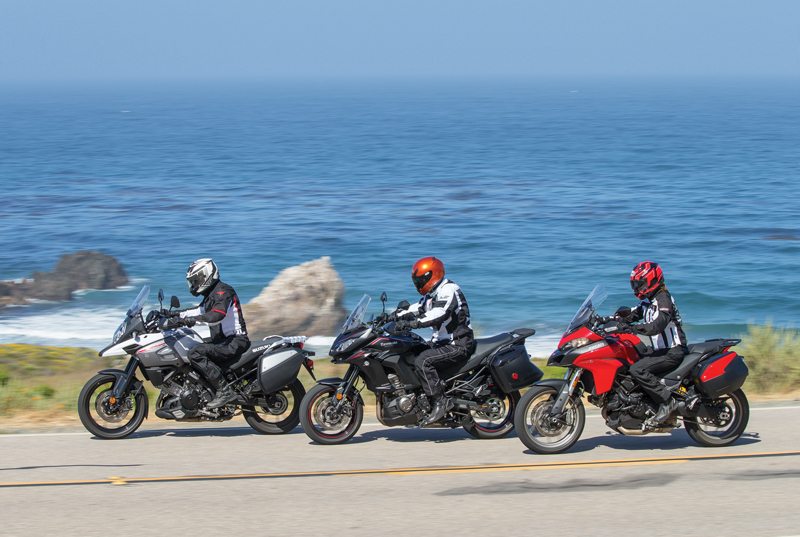
All have upright seating positions with a modest reach to the handlebars. The Ducati has the widest handlebar, the shortest distance between the seat and footpegs, and a seat that’s U-shaped front-to-back, locking the rider into place. With seats that are flatter toward the back, the Kawasaki and Suzuki provide more room to stretch out. The Kawasaki’s seat is the plushest, but all three offer good comfort and support. Hands down, the Kawasaki’s saddlebags are the roomiest (each 28-liter bag swallows a full-face helmet) and easiest to use. Although the Ducati’s saddlebags have a higher total capacity (58 liters vs. 56 for the Kawasaki’s) and are also easy to use, the muffler limits space on the right side and the left bag’s internal shape makes a small-size full-face helmet a snug fit. At 39 liters of total capacity, the Suzuki’s saddlebags are too small and the latches gave us fits.
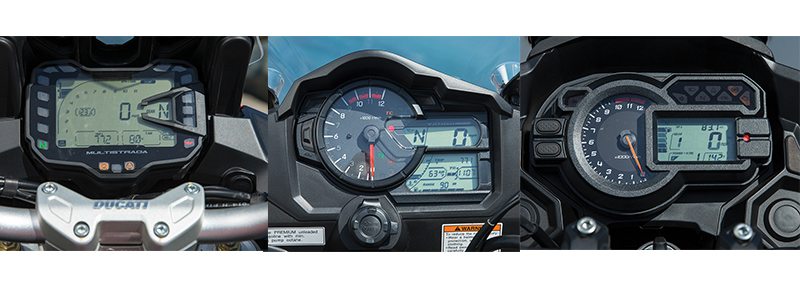
Pecking Order
If you’re never going to leave the pavement, the obvious choice is the Kawasaki Versys 1000 LT, which has the lowest price, the most powerful engine, agile handling, all-day comfort and standard saddlebags. But if you’re like us and enjoy exploring backcountry byways, then it comes down to the Ducati Multistrada 950 or Suzuki V-Strom 1000 with their 19-inch front wheels, extra suspension travel and 90/10 adventure tires. Although the Ducati is a blast on racer road, its lack of low to midrange power and quirky brakes, clutch and seat turned us off. In the end, the venerable V-Strom is our pick. It lacks some of the excitement of the others, but it’s a versatile, solid motorcycle that packs low-end punch and has the added benefit of cornering ABS. We’d skip the small, fiddly saddlebags and bolt on a set of boxy, top-loading aluminum panniers to take everything we need for our next adventure.
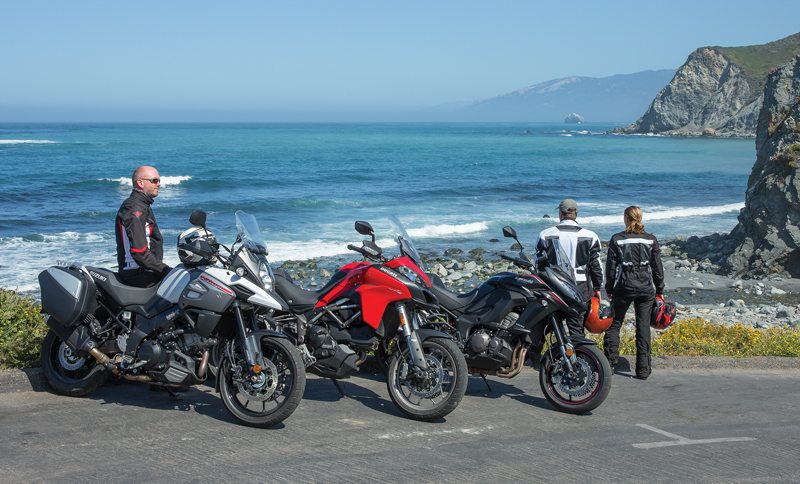
In Detail: 2017 Ducati Multistrada 950
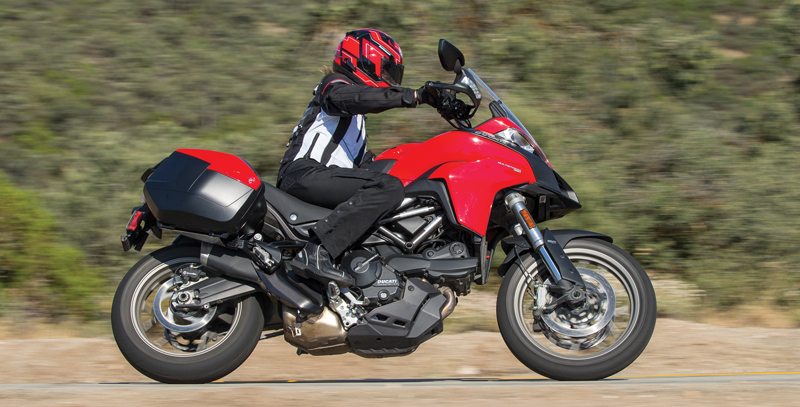
With sharp-beaked styling, sensible ergonomics, a superbike-derived 1,198cc L-twin and “four bikes in one” riding modes, Ducati’s Multistrada 1200 nearly clinched Rider’s Motorcycle of the Year when it debuted for 2010. In the years since, the Multistrada has evolved, becoming more user-friendly, more powerful and more sophisticated, with the latest models boasting 160 horsepower and state-of-the-art electronics. They also have MSRPs above $20,000.
Which is why Ducati rolled out the Multistrada 950 for 2017, a lighter, less expensive version that’s powered by a 937cc version of the Testastretta 11˚ L-twin and foregoes some of the electronics found on the 1200s. Like its big brothers, the 950 has four riding modes (Sport, Touring, Urban and Enduro) that automatically adjust engine output, throttle response, traction control and ABS, but it doesn’t have cornering ABS, semi-active suspension or other electronic rider aids. The 950 weighs 10-60 pounds less than the various 1200 models and has a base price of $13,995.
Standard equipment includes two 12V power outlets, a USB socket, hand guards and a luggage rack. We added Ducati’s factory accessory saddlebags and mounting kit ($931) along with color-matched panels ($175). A better deal is the $969 Touring accessory package, which includes saddlebags, mounting kit and a centerstand.
2017 Ducati Multistrada 950 Specs
Base Price: $13,995
Price as Tested: $15,139 (saddlebags)
Warranty: 2 yrs., unltd. miles
Website: ducati.com
Engine
Type: Liquid-cooled, transverse 90-degree L-twin
Displacement: 937cc
Bore x Stroke: 94.0 x 67.5mm
Compression Ratio: 12.6:1
Valve Train: Desmodromic DOHC w/ 4 valves per cyl.
Valve Insp. Interval: 18,000 miles
Fuel Delivery: EFI w/ 53mm throttle bodies x 2
Lubrication System: Wet sump, 3.6-qt. cap.
Transmission: 6-speed, cable-actuated wet assist-and-slipper clutch
Final Drive: O-ring chain
Electrical
Ignition: Electronic digital
Charging Output: 500 watts max.
Battery: 12V 12AH
Chassis
Frame: Tubular-steel trellis w/ cast aluminum swingarm
Wheelbase: 62.8 in.
Rake/Trail: 25.2 degrees/4.2 in.
Seat Height: 33.1 in.
Suspension, Front: 48mm USD fork, fully adj. w/ 6.7-in. travel
Rear: Single shock, fully adj. w/remote preload & 6.7-in. travel
Brakes, Front: Dual 320mm semi-floating discs w/ opposed 4-piston radial calipers & ABS
Rear: Single 265mm disc w/ 2-piston floating caliper & ABS
Wheels, Front: Cast, 3.0 x 19 in.
Rear: Cast, 4.5 x 17 in.
Tires, Front: 120/70-R19
Rear: 170/60-R17
Wet Weight: 541 lbs. (as tested)
Load Capacity: 484 lbs. (as tested)
GVWR: 1,025 lbs.
Performance
Fuel Capacity: 5.3 gals., last 1.1 gals. warning light on
MPG: 91 PON min. (low/avg/high) 42.0/46.0/53.5
Estimated Range: 244 miles
Indicated RPM at 60 MPH: 3,900
In Detail: 2017 Kawasaki Versus 1000 LT
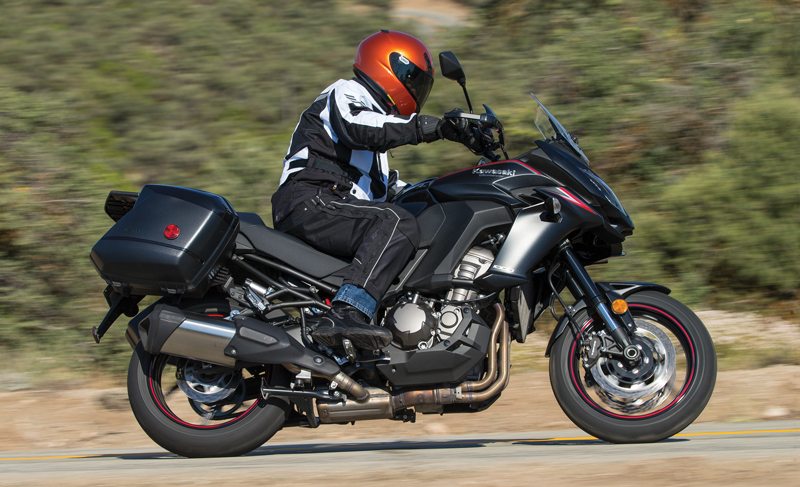
We’ve been fans of the Versys since the 650 model was introduced for 2008. By combining the Ninja 650’s user-friendly parallel twin and 17-inch wheels with tallish suspension and upright ergonomics, Kawasaki created a fun, nimble, affordable “street adventure” bike with a funky name and even funkier styling. In 2015, a revamped, restyled Versys 650 was joined by a liter-sized version based on the Ninja 1000, and we were so impressed by the Versys 1000 LT that we named it Motorcycle of the Year and kept one in our long-term fleet. Except for the color (it’s only available in Metallic Flat Spark Black for 2017), it hasn’t changed over the past two years.
The Versys 1000’s liquid-cooled, 1,043cc in-line four with DOHC and 4 valves per cylinder uses a mechanical throttle rather than electronic throttle-by-wire, but it has two fuel-injection maps, one for Full power (100 percent) and one for Low power (75 percent). Standard safety features include nonswitchable ABS and traction control with three modes plus off, and standard touring equipment includes hand guards, a centerstand, a luggage rack and saddlebags. It doesn’t have a 12V power outlet, but one can be added as an accessory for $84.95.
2017 Kawasaki Versys 1000LT Specs
Base Price: $12,999
Warranty: 2 yrs., unltd. miles
Website: kawasaki.com
Engine
Type: Liquid-cooled, transverse in-line four
Displacement: 1,043cc
Bore x Stroke: 77.0 x 56.0mm
Compression Ratio: 10.3:1
Valve Train: DOHC, 4 valves per cyl.
Valve Insp. Interval: 15,200 miles
Fuel Delivery: DFI w/ 38mm throttle bodies x 4
Lubrication System: Wet sump, 4.2-qt. cap.
Transmission: 6-speed, cable-actuated wet assist-and-slipper clutch
Final Drive: O-ring chain
Electrical
Ignition: TCBI w/ digital advance
Charging Output: 413 watts max.
Battery: 12V 8AH
Chassis
Frame: Twin-spar aluminum w/ tubular-steel subframe & cast aluminum swingarm
Wheelbase: 59.8 in.
Rake/Trail: 27 degrees/4.0 in.
Seat Height: 33.1 in.
Suspension, Front: 43mm USD fork, adj. for spring preload & rebound damping w/ 5.9-in. travel
Rear: Horizontal back-link shock, adj. for spring preload (remote) & rebound damping w/ 5.9-in. travel
Brakes, Front: Dual 310mm petal discs w/ opposed 4-piston calipers & ABS
Rear: Single 250mm petal disc w/ 1-piston pin-slide caliper & ABS
Wheels, front: Cast, 3.5 x 17 in.
Rear: Cast, 5.5 x 17 in.
Tires, front: 120/70-ZR17
Rear: 180/55-ZR17
Wet Weight: 564 lbs.
Load Capacity: 470 lbs.
GVWR: 1,034 lbs.
Performance
Fuel Capacity: 5.5 gals., last 1.0 gal. warning light on
MPG: 91 PON min. (low/avg/high) 38.9/42.9/46.1
Estimated Range: 236 miles
Indicated RPM at 60 MPH: 3,600
In Detail: 2018 Suzuki V-Strom 1000
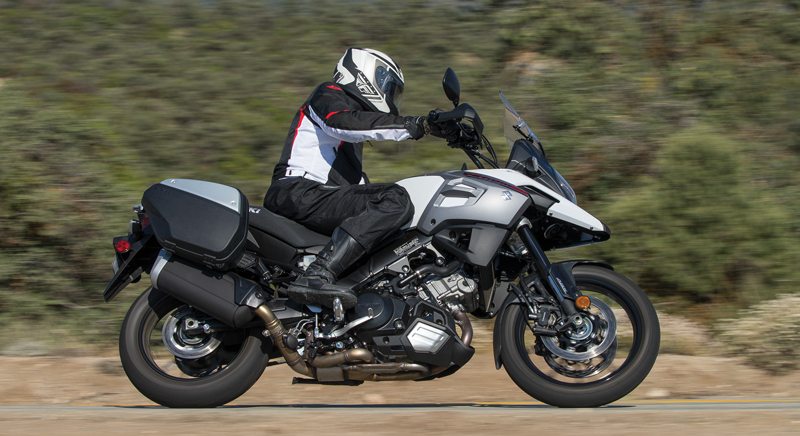
In addition to the Kawasaki Versys 1000 LT, the Suzuki V-Strom 1000 is the other former Motorcycle of the Year in this comparo, having won 15 years ago when it was introduced for 2002 as a “sport enduro tourer.” A major redesign for 2014 included a larger 1,037cc V-twin that made more power and torque, an assist-and-slipper clutch, a new traction control system, a lighter, stronger chassis, less weight and new styling. Updates for 2018 include engine refinements to meet Euro4, Low RPM Assist, a minor styling refresh, a taller reshaped windscreen, hand guards with larger bar-end weights and a lower engine cowl. On the safety front, the V-Strom 1000 has a new five-axis inertial measurement unit (IMU) and what Suzuki calls Motion Track ABS and Combined Braking — also known as cornering ABS — yet the base price increased by only $300, to $12,999. Another $300 gets you the XT model, which adds tubeless spoked wheels and a Renthal Fatbar handlebar.
Standard touring equipment includes a 12V socket on the dash, hand guards and a luggage rack, which is flush with the passenger seat to make it easy to mount a tail bag or duffel. We added Suzuki’s factory accessory saddlebags ($725.95) and mounting brackets ($99.95). A centerstand can be added for $284.95.
2018 Suzuki V-Strom 1000 Specs
Base Price: $12,999
Price as Tested: $13,825 (saddlebags)
Warranty: 1 yr., unltd. miles
Website: suzukicycles.com
Engine
Type: Liquid-cooled, transverse 90-degree V-twin
Displacement: 1,037cc
Bore x Stroke: 100.0 x 66.0mm
Compression Ratio: 11.3:1
Valve Train: DOHC, 4 valves per cyl.
Valve Insp. Interval: 14,500 miles
Fuel Delivery: EFI w/ 45mm throttle bodies x 2
Lubrication System: Wet sump, 3.7-qt. cap.
Transmission: 6-speed, hydraulically actuated wet assist-and-slipper clutch
Final Drive: O-ring chain
Electrical
Ignition: Electronic transistorized
Charging Output: 490 watts max.
Battery: 12V 12AH
Chassis
Frame: Twin-spar aluminum w/ tubular-steel subframe & cast aluminum swingarm
Wheelbase: 61.2 in.
Rake/Trail: 26.5 degrees/4.4 in.
Seat Height: 33.5 in.
Suspension, Front: 43mm USD fork, fully adj. w/ 6.3-in. travel
Rear: Linked shock, adj. for spring preload (remote) & rebound damping w/ 6.3-in. travel
Brakes, Front: Dual 310mm discs w/ opposed 4-piston radial calipers & ABS
Rear: Single 260mm disc w/ 1-piston pin-slide caliper & ABS
Wheels, Front: Cast, 2.5 x 19 in.
Rear: Cast, 4.0 x 17 in.
Tires, Front: 110/80-R19
Rear: 150/70-R17
Wet Weight: 529 lbs. (as tested)
Load Capacity: 436 lbs. (as tested)
GVWR: 965 lbs.
Performance
Fuel Capacity: 5.3 gals., last 1.2 gals. warning light on
MPG: 91 PON min. (low/avg/high) 37.2/39.7/45.5
Estimated Range: 211 miles
Indicated RPM at 60 MPH: 3,500

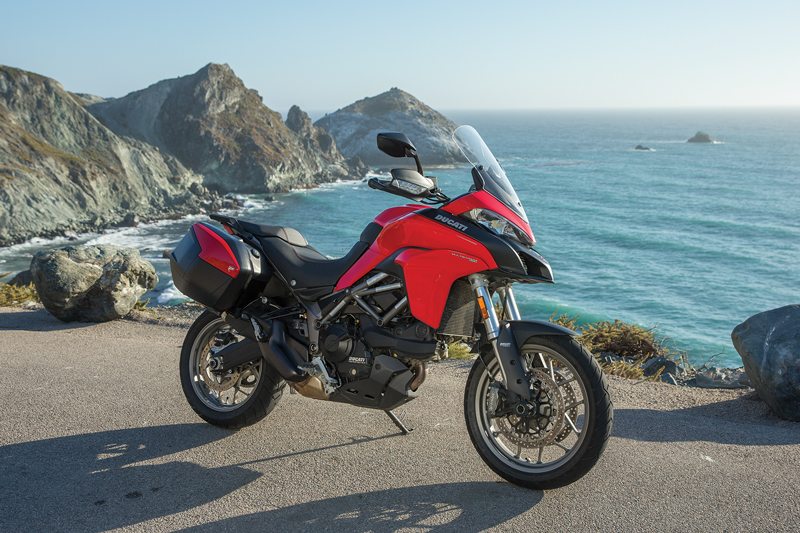
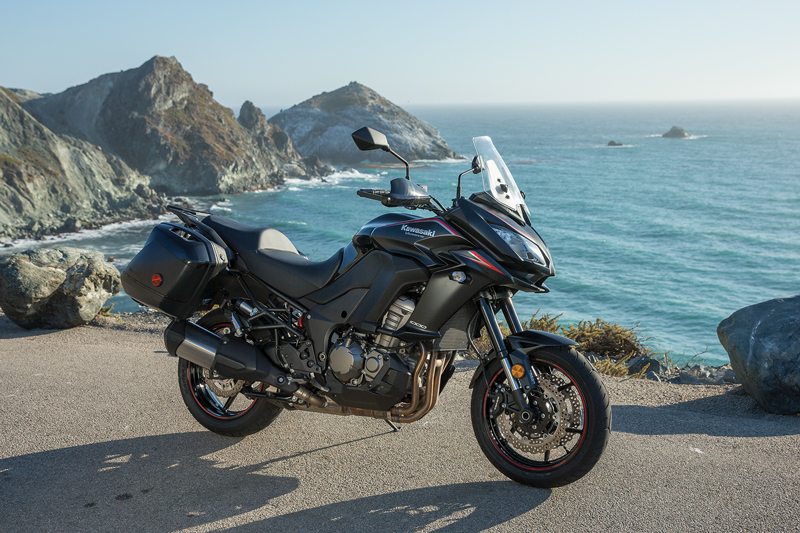
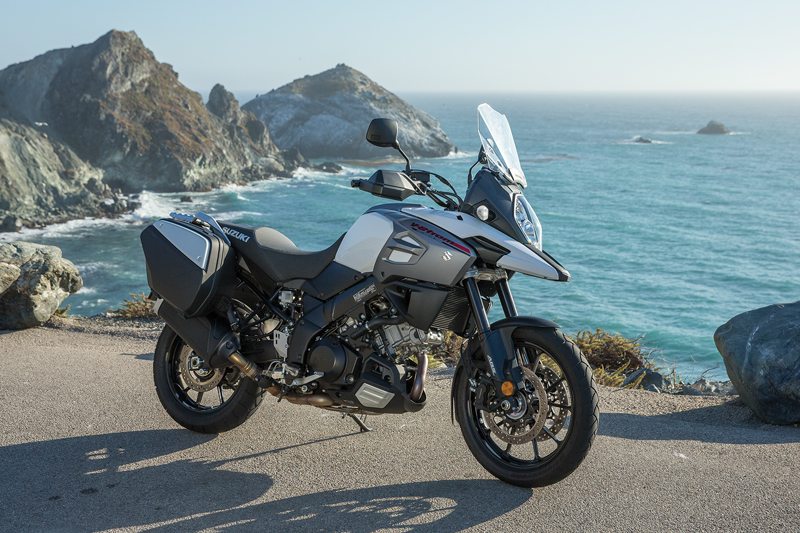
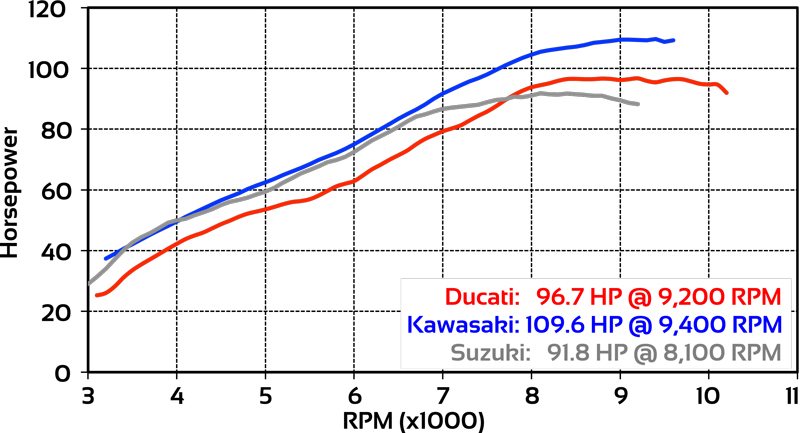
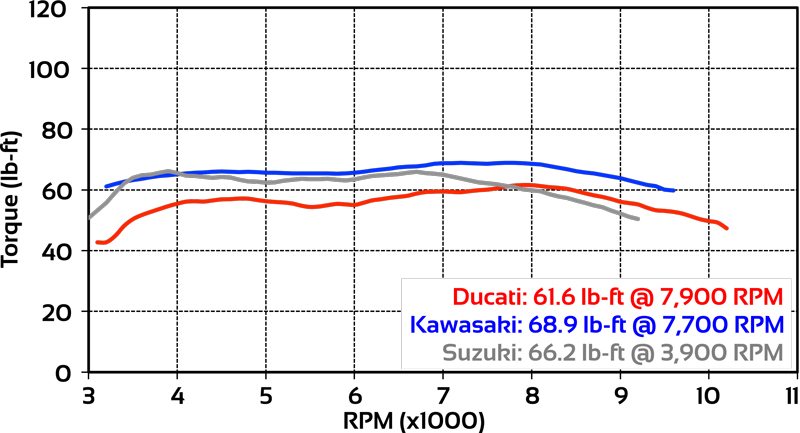
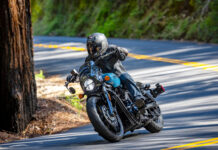






I’ve ridden the Ducati 950 for many miles. I’m not sure how you guys managed to bury its potential but I disagree in a big way. I found it extremely smooth in high speed corners, full of torque when requested and more top end than most bikes under 1000cc’s. I was very disappointed in this article.
Brent, it was a comparison test – if you not ridden it in conjunction with the others (as the testers have) then you are unaware of the differences. I’m sure their comments weren’t personal.
Having ridden the multistrada and Vstrom I can verify their comments as to engine performance. If you are content to loaf along while touring the Vstrom has the multistrada well and truly covered. It’s always peaceful to live with and with tons of torque on tap
can you guys get basic bike characteristics right? the Ducati weigh 504 wet , the Suzuki is 514 wet ! come on
it was noted “as tested”. Why would you feel the need to question their results? It’s well known that manufacturers can be a little tricky in their weight disclosure
This test also is clear about the additional side cases, which accounts for this extra weight.
Having been riding for more than 50 yrs I all kind of motorcycles I can tell you that there is a point in wich this comparisons are reduced to the riders abilyty. There might be diferences in each but in the end the rider is the main one. I have a VStrom 1000 2014 and I can ride along and some times even better than guys in BMW GS, Yamaha Super Tenere or Ducatti Multistrada 1198. I live in Guatemala. Cheers to all riders!!!
Very good article. Didn’t seem biased or fluffy.
One thing is like to see addressed in future reviews is ease of maintenance, frequency of maintenance, cost of dealer maintenance and cost of parts. These are real world factors that are never considered by reviews.
Agreed. I’d also like to know the range since I hear Multistrada requires frequent gas drops compared to others. It is a good article and. Hope to hear updates.
A review picks the Suzuki. Again. Why? Add the luggage and the centerstand and it’s $1000 more. The Suzuki has had clutch basket and stator issues and recalls. Optional centerstand. Cheap and dumb. Now since when is a bike with a chain sold without a centerstand? Ever put tires on without one? Oil the chain without one?
The test graphs show the Kawasaki has more torque at all RPMs and more horses. The Suzuki is always touted for its low RPM torque, but the Versys wins in that category.
I don’t get it. And lots of buyers never intend to take them off-road, just like most 4-wheel drive cars and SUVs. Advantage: Suzuki!